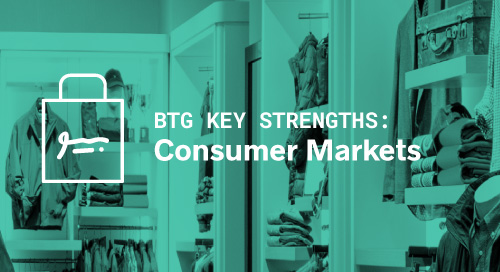
There is no question that the COVID-19 pandemic profoundly shifted the way retailers and consumer goods companies connect with and serve their customers—from capturing their attention online to integrating service and delivery into the customer experience.
While the topmost concern of retailers in the past might have been securing optimal real estate and square footage, today a vast proportion of the customer’s experience takes place in the increasingly cluttered online arena—a shift that was already underway pre-pandemic but which has only been accelerated by seismic shifts in consumer behavior over the past few years. Now, the key factors that can make or break a brand are accessibility, ease of purchasing, and the speed of service.
Although retailers have proven incredibly resilient—by adjusting and optimizing supply chains, scaling ecommerce, rolling out contactless payments and digital/physical experiences, and doubling down on personalization—significant opportunities remain to build more engaging customer experiences, drive brand loyalty, and deliver seamless, satisfactory service. At the same time, retailers face increased challenges in the form of economic pressures and continuing supply chain struggles.
Fortunately, adept and experienced high-end independent talent are ready to dive in and help leading consumer companies kickstart recovery, facilitate stability, and strategize their next steps. BTG reached out to Rachael Ulman, an experienced retail executive, to discuss current trends playing out across the ecommerce and retail landscape—and what might be coming next as another wave of uncertainty looms on the horizon.
Meet The Expert

Rachael Ulman
Rachael Ulman is the Founder and CEO of 27 Edge, a strategy consulting firm helping retail and consumer brands grow through omnichannel and ecommerce expansion.
What are the big trends retailers should be focusing on for 2022 and beyond?
Retailers are focusing on two significant post-pandemic impacts: accelerated adoption of online shopping and record post-pandemic inflation.
First, ecommerce sales surged during the pandemic, with consumers having no other option than to adapt to online shopping. Even in categories like grocery, ecommerce adoption rates accelerated 10+ years in a matter of months. Now, as many customers return to stores and physical sales increase, ecommerce adoption is expected to persist above pre-pandemic levels. In 2022 and beyond, customers are expected to continue to shop online for a broader set of categories and use services that they adopted during the pandemic, like BOPIS (Buy Online, Pickup in Store) and mobile checkout.
Second, coming out the pandemic, retailers are dealing with an environment of record inflation impacting both retail prices and costs. As inflation impacts consumer spending, retailers will need to adjust their inventory levels and reduce their operating expenses. For example, we are already seeing some retailers having to significantly markdown excess inventory in pandemic categories like TVs, small kitchen appliances and furniture as demand softens.
How do you see the online-to-offline experience, like BOPIS, continuing or evolving post-COVID?
Buy Online, Pickup In Store (BOPIS) is tablestakes now. According to the Omnichannel Retail Index 2022 report released by OSF, 84% of leading retailers across different categories offer BOPIS (up from 33% in 2016). The pandemic accelerated adoption and retailers have invested to offer a better service. Anticipated further improvement areas for BOPIS include:
- Geolocation-based pickup services to shorten customer wait times
- Reconfigured stores that have dedicated space for staging orders and customer pickup
- Faster click to pickup times in < 30 minutes
- Inventory accuracy improvements through real-time data integration and predictive models
How can brands capture consumer attention amongst countless digital distractions?
Anyone who has scrolled TikTok while watching Netflix knows the power of digital distractions. Marketers are adapting to this new hyper digital world. From influencers to NFTs, there are a myriad of marketing options available. Two trends worth watching:
- There was a seismic shift in digital marketing with the impact of Apple’s iOS privacy change in 2021. Advertising performance on platforms such as Facebook, Instagram, and Snap that rely on off-platform interaction data has been significantly impacted. As a result, we are seeing retailers invest more in 1st party data (e.g., transaction data, loyalty programs, referral programs) to reach customers. Leveraging 1st party data, retailers can create hyper-personalized and relevant experiences for their customers and offer digital advertising opportunities for their brands.
- Second, given the value of 1st party data, we can expect Amazon to be a big winner in digital advertising. Currently, Amazon is the 3rd largest digital ad platform (after Google and Meta) and the fastest growing of the three. Given its massive customer transaction database, Amazon has clear signals on customer preferences, intent, and purchase behavior. Over the next several years, we expect to see more brands advertise on Amazon, whether they sell on Amazon or not.
How can ecommerce companies and retailers best gather, utilize, and monetize their data?
Data is one of retail’s most important assets. Large retailers such as Walmart and Amazon have been able to create competitive advantages by leveraging data to improve everything from supply chain operations to the customer experience. As the saying goes, “retail is detail”, and information is the bedrock for good decision making.
Data gathering:
Before cloud computing, retail data was stored on owned, dedicated servers which were difficult to access or integrate. Cloud services, like Google, Microsoft, and AWS, have unlocked retail data allowing for reduced maintenance costs, more reliability, and easier data access. We have seen many retailers migrate to these cloud services to host their data and expect this trend with continue.
Data utilization:
A suite of data warehouse tools and services have been developed to allow for easier sharing, analysis, and interpretation of retail data. These span from “data warehouse as a service” companies like Snowflake, to data engineering and machine learning tools like Databricks. Retail organizations are staffing up their data science teams to automate and improve decision-making like never before.
Data monetization:
Smart retailers are recognizing the value of their data and monetizing it. Many retailers monetize their data with their vendor partners by selling them premium data access or through advertising opportunities on their retail media networks. An often untapped but new opportunity is to monetize anonymized transaction data. One company that is helping across all of these areas is Banyan, which leverages receipt-level data to help retailers securely monetize their transaction information, reduce fraud, and provide more personalized customer experiences.
Get the ecommerce and retail expertise you need.
As leading retailers and consumer goods companies seek to accelerate digital transformations and ecommerce initiatives to meet changing consumer behaviors, independent talent are a crucial source of in-demand skills and expertise to fill critical leadership gaps, transform processes and supply chains, and revolutionize digital marketing strategies. Reach out today to start a project with Rachael Ulman or another highly skilled independent talent from Business Talent Group.
GET THE SKILLS YOU NEED
Thousands of independent consultants, subject matter experts, project managers, and interim executives are ready to help address your biggest business opportunities.












